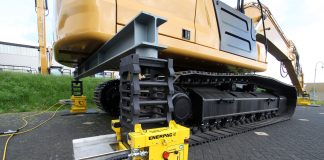
Concrete contractors may select from four types of pumps for wet shotcrete processes or use a rotary gun for dry processes
By Jim Farrell, President and CEO of Blastcrete Equipment
Decisions, decisions. A concrete contractor’s success comes down to more than hard work.
It involves the decisions he or she makes — including equipment choices to deliver a high return on investment. Selecting the right concrete pump for the job ensures success and eliminates the need for frequent maintenance and repairs.
Contractors may select from four types of pumps for wet shotcrete processes or use a rotary gun for dry processes. Here’s a guide to help with the decision-making process.
Hydraulic swing tube pumps
Use a swing tube pump for projects involving harsh materials and long-distance pumping. These pumps come in sizes with 7.5 cm and 10 cm outlets. The 7.5 cm pump works great for jobs from 1.5 to 6 cubic metres per hour, while the 10 cm pump tackles jobs that require 6.8 to 15 cubic metres per hour. The output or material pressure at pump discharge from a swing tube pump varies from 750 psi up to 2,100 psi.
Clean the pumping system properly after each use to avoid premature wear on the cup seals and material pumping tubes. A swing-out or hydraulic lift hopper offers easy and quick access for cleaning and maintenance.
For best results, generously grease the outgoing housing, swing tube shaft and swing tube cylinders during each hour of operation, and ensure it’s always operated by a well-trained and experienced worker.

Squeeze tube or peristaltic pumps
Squeeze pumps provide the lowest output pressure when compared to swing tube, rotor stator or ball seat pumps.
The maximum output pressure at pump discharge is 500 psi. As a result, squeeze pumps don’t work well for pumping larger than 125 mm aggregate, exceeding 15 metres vertically or moving material more than 76 metres horizontally.
The slump of the material should not be less than 7.5 cm. Squeeze pumps are preferred for cellular concrete because the lower pressure does not damage the bubbles in this material. Squeeze pumps have also been used successfully to pump shotcrete with steel and synthetic fibres.
You may also like:
- Our Top 5 jobsite stories of 2018
- Tips for selecting the right modern fuel storage solution
- Gomaco to debut Xtreme GT-3600 at World of Concrete
The lower pumping pressure makes a squeeze pump the safest to operate and, in many cases, customers with no concrete pumping experience can operate a squeeze pump.
Not only that, but squeeze pumps offer the easiest maintenance. They contain only one wear part, the rubber pumping tube, which is replaceable in about 30 minutes. Operators are also able to clean them quickly by simply pushing a sponge ball through the pump.
Hydraulic ball valve pump
The ball valve pump delivers as much as 1,100 psi pumping pressure. However, it is limited to 10 mm aggregate and a slump that is 7.5 cm or larger. The ball valve pump will not run in reverse, therefore extreme caution must be taken to relieve pressure on the delivery line should the line plug.
There is a small ball valve on the discharge pipe of the manifold to manually relieve this pressure. Materials such as gypsum flooring materials, which are very plastic in nature, tend to build up over time in the receiving hopper and manifold. Shotcrete materials do not have these same characteristics and will work well provided the aggregate does not exceed 10 mm in diameter.
These pumps offer the advantage of a low purchase price and easy maintenance.
Rotor stator, screw, progressive cavity or worm pumps
Most applications for rotor stator pumps use the low-velocity or spray-up method. A rotor stator pump generates as much as 600 psi of pumping pressure. These pumps are commonly used for pumping highly flowable materials, but they also tolerate small aggregate.
Aggregate that is too sharp may result in premature stator wear, and rotor stator pumps typically wear fast when used for material with aggregate that’s larger than 3 mm. They cannot be run dry of material without causing damage to the stator. Rotor stator pumps offer about 30 per cent more pumping pressure than a squeeze pump.
Look into the mechanical seal maintenance requirements manufacturers offer for rotor stator pumps. It’s important to select a model that gives operators the ability to perform mechanical seal maintenance without taking apart the rotor and stator. This drastically reduces labour expenses, keeping equipment where it’s profitable: on the jobsite. Rotor stator manufacturers recommend cleaning the machine by flushing the pump and delivery system with water.
Rotary gunite machine
Use a rotary gunite machine for dry shotcrete processes. These machines offer precise control of material flow for low or high outputs. The speed the rotor turns is directly related to the amount of material that will pass through the rotor section.
These can be powered with an electric motor, air motor, gas or diesel engine or hydraulics. The rotary gun is also available as a skid steer work tool. The dry shotcrete process means the material remains dry until it is properly hydrated at the nozzle. Best results occur if the material has 3 to 5 per cent moisture when loaded into the hopper of the gunite machine. Pre-dampen the material, if needed, to accomplish this.
These machines offer easy stop and start with no cleanup. However, they generate more dust and waste, particularly if not properly hydrated.
With these guidelines as a reference, concrete contractors set themselves up to make the best decision for their jobs.
Blastcrete Equipment LLC has been manufacturing safe, reliable and user-friendly solutions for the refractory and shotcrete industries for more than 60 years. With a complete product line that consists of concrete mixers, pumps and related products, the company serves the commercial and residential construction, ICF and SCIP building systems, refractory and underground markets.












